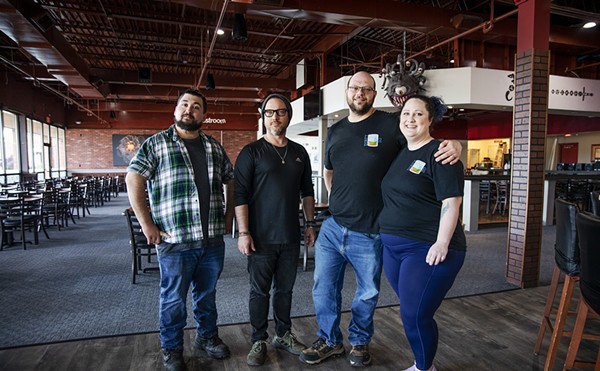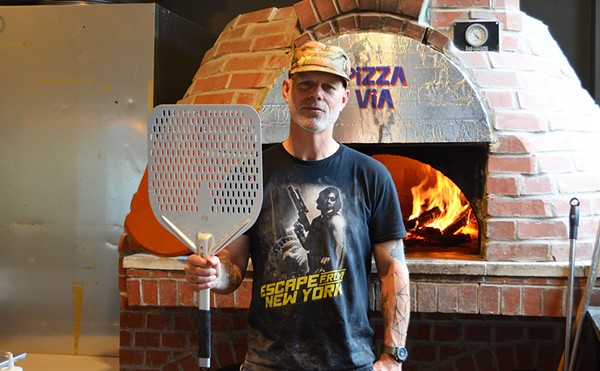The many Buddhas that adorn the shelf behind the drinks bar at Sansui are now smiling just a bit wider.
Thanks to a new owner named Naomi Hamamura — "Hama-san" to just about everyone — and a new sushi chef known, much like Elle, Fabio and Pelé, as just plain Kenji, the 14-year-old Japanese restaurant in the Central West End has risen to a higher plane, offering good Japanese staples, excellent sushi and exceptional specialty dishes for those willing to wander the path less traveled.
When Sansui first opened, it was basically out the back door of the apartment I lived in then, and given my fondness for sushi, I ate there frequently. Over the years, however, it has occasionally suffered from, well, idiosyncratic behavior (sushi chefs came and went, and in one case a hostess actually shouted at a friend of mine for asking to sit authentic-Japanese-style in a matted booth).
Hamamura and staff seem to be much more attuned to traditional Japanese hospitality (although Kenji-san seems a tad shy for a sushi chef). Hama-san is familiar to local food cognoscenti for a hidden gem called the Forest Cafeteria that he ran in Maplewood in the early '90s, and also as an award-winning ice sculptor who worked for some time at the Ritz-Carlton. A graduate of the Japan Culinary School in Osaka, he has been in this country since 1980.
In taking over Sansui, he inherited a charming, definitively Japanese space at the base of a rather sterile high-rise apartment building that was put up less than 20 years ago on West Pine, within sight of Forest Park. Outside, you're greeted by a working water wheel and meticulously maintained rock-and-flower garden; once you enter, the drinks bar and waiting area are to the right of the wide but shallow space, with a 12-seater sushi bar against the back wall and about 12 blond-wood tables — some freestanding, some boothed off by wood-and-paper-screened half-walls — cleanly arranged throughout the rest of the dining area. The aforementioned traditional booths — up a step and featuring floor seating, which mandates shoe removal for proper form — are farthest from the door. The transportation to somewhere in Japan is aided by an additional paper screen at seated-eye-level across the front plate-glass windows, resulting in a somewhat surreal view of dogs and legs from the passing cityscape.
Sushi isn't everyone's cup of cha, so to speak, so despite the fact that our recent visits to Sansui were loaded with raw fish and some even more over-the-edge items (more on that later), don't avoid Sansui if someone in your party plays it pretty straight with restaurant food. There are plenty of approachable choices among both appetizers and entrees, like tempura (lightly battered shrimp and vegetables), Japanese breaded cutlets, teriyaki meats and grilled seafood.
We, on the other hand, probably would have ordered the grilled head of sea bream if we had still had room, and in fact we did try several choices among the handwritten specials behind the sushi bar, which is where you'll find some of the most adventurous items to be found on any St. Louis menu. The bonito sashimi ($9.75) was a stunning selection, a long fillet divided into 10 double slices, looking a lot like a tiny rack of lamb without the bones. The fillet was garnished with shredded daikon radish, radish sprouts and minced scallions and garlic, and you could tuck these condiments in between the slices and end up with a burst of flavor to match the gentle, rare-beef texture and flavor of the fish itself.
We played it safer with a couple of our other appetizers. The dumplings called gyoza ($3.75) have similarities to items from many other cultures, from the potstickers of Chinese restaurants to the pierogis of Eastern Europe. The Sansui preparation was simple and elegant, with delicate doughy casings and a mild sausagelike flavor in the filling. The shumai ($3.75) were also dumplings, but more in a bonbon shape and with a crab filling, plus an unusual wasabi (horseradish mustard) that was golden instead of the expected green color.
Kenji-san's sushi was uniformly excellent. We made a whole dinner out of one meal, sampling better-known items like the translucent maroon maguro (tuna), yellowtail roll and the inside-out crab-and-avocado California roll but also taking in more unusual items like akagai (ark shell) and the densely flavored sea- urchin roe called uni, which was topped off with a raw quail egg. In an illustration of Kenji's meticulous presentation, the squid in the hand-rolled squid roll came out looking remarkably like the signature facade of the Sydney Opera House. If you know what you're doing, order the sushi a la carte, but if you want a preselection from the chef, these are available in many forms, up to and including an eight-piece omakase (where Kenji shows off his skills with the best items of the night for $19.50), and a serves-three "Sansui Boat" ($35.50) and a serves-five "Love Boat" ($59.50), both of which are presented in wooden boats.
An excellent alternative for a straightforward tour of Japanese cuisine is the Sansui bento ($16.50). Bentos are generally meals divided into segmented boxes, sometimes delivered like three-dimensional puzzle boxes, but in this case all on a single rectangular serving platter, with a centerpiece of a grilled, sweetened-soy-sauced fillet of swordfish. Other compartments included sashimi of tuna, octopus and asparagus; roasted onion and squash dressed with soy and sesame oil; tempura of shrimp, broccoli and yam; pickled-seaweed salad; and steamed rice flavored delicately with spiced seaweed. It's a remarkable full meal for the price.
And, finally, let's touch on the "not for everyone" category from among the handwritten specials. Sansui features not one but two versions of monkfish liver, which sounds pretty risky but ended up being right up there with oysters, goat cheese and especially foie gras on my personal list of culinary risks that ended up with high rewards. The fish liver is fairly close in flavor or texture to the goose or duck liver that goes into foie gras, and the Sansui version we tried ($6.75) had just a hint of fish flavor that was heightened by a sprinkling of bright-orange fish roe. Five slices were served on a bed of greens dressed with an Orientally flavored thousand-island-style dressing, with asparagus tips alongside for additional contrasting flavor and texture. If you're going to dine on the edge, this is a marvelous way to expand your horizons.
One thing to keep in mind on a sushi outing is that one sushi chef can only make so much sushi at a time, and so, especially at prime time, allow yourself a liberal schedule. Sansui's folks were smart enough on one visit to start warning people that sushi orders would take at least a half-hour, which could put some diners off, but you simply can't rush quality in preparation like this.
The new Sansui has certainly followed a noble path, and local diners have a chance at their own greater enlightenment (accompanied by a relatively modest lightening of their wallets) if they give it a try.
SANSUI 4955 W. Pine Blvd. (Central West End), 367-2020. Hours: lunch, 11:30 a.m. -2 p.m. Mon.-Fri.; dinner, 5:30-10 p.m. Mon.-Thurs., 5:30-11 p.m. Fri.-Sat. Entrees: $10.95-$16.50. Sushi: $1.75-$4.50.





